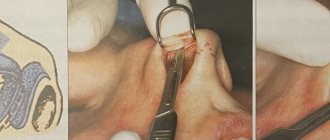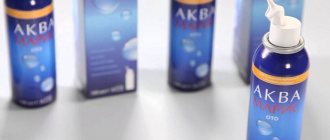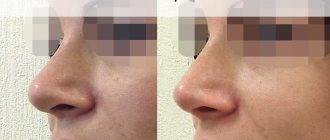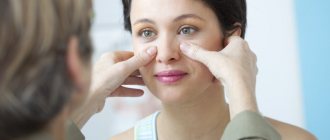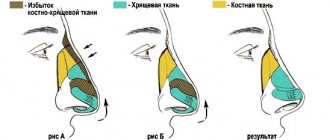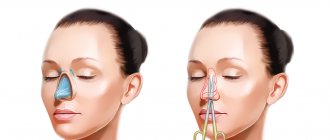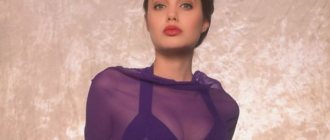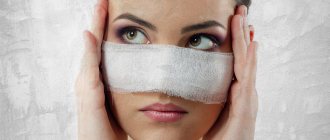Often a new nose becomes synonymous with a new life. It radically changes a person’s appearance, harmonizing facial features as much as possible. Therefore, rhinoplasty, a surgical change in the shape, length, and size of the nose, ranks second in popularity among plastic surgeries. Data from the International Society of Aesthetic Plastic Surgery (ISAPS) shows the following figures: in 2022, more than 1.2 million nose jobs were performed. In terms of demand, it is surpassed only by breast augmentation.
The success of any surgical intervention depends not only on the plastic surgeon. The recovery period plays an important role, when you should strictly follow the recommendations of a specialist.
I talked about the indications for the operation and the features of its implementation. Now I want to draw attention to recovery after rhinoplasty of the nose, how it goes, what can be done, and also what factors contribute to rapid healing without consequences.
Stages of the operation
The entire process of surgical intervention can be divided into several stages.
Anesthesia . The operation is performed under general anesthesia. At the Vidnova Clinic we use modern inhalation anesthesia, which is used in all well-known European medical institutions. Today it is considered the safest for the patient’s health. Inhalation anesthesia provides a quick immersion of the patient into a deep, medicated sleep, and then an easy exit from it. Hallucinations are excluded.
Methodology. Modern plastic surgery distinguishes 2 techniques: open and closed. The technique of performing nose surgery largely determines the features of rehabilitation.
The open technique requires a small incision to be made in the colummel (the strip of skin located between the nostrils) and along the edges of the greater alar cartilage. This provides the plastic surgeon with optimal visualization. The closed method is at the peak of popularity today. It is rightfully considered the most gentle and preserving. Its advantage is the absence of external incisions.
Let me note that in my practice I use Swiss Bien Air microsaws. They are the standard of plastic surgery of the nose. The work is done accurately, delicately, and as efficiently as possible. The result of the operation is 100% consistent with the result that we obtained during 3D modeling.
If indicated, septoplasty is performed along with aesthetic rhinoplasty - correction of a deviated nasal septum, which leads to breathing problems. Recovery after rhinoseptoplasty is no different from rehabilitation after aesthetic correction.
Which technique is right for you? This issue is discussed individually during the consultation. Consultation is free in Zaporozhye and Dnieper.
The final stage. The duration of surgery depends on the volume. The operation approximately lasts 1-2 hours. If open plastic surgery was performed, the wound is sutured with cosmetic threads.
Septal splints
Recently, septal splints or intranasal splints have become an integral part of operations on the nasal septum. For septoplasty, rhinoseptoplasty and closure of perforations of the nasal septum, the final stage of the operation is the installation of septal splints on both sides of the nasal septum.
The reason splints are so popular among surgeons is a number of advantages that improve the outcome of the operation, reduce the risks of postoperative complications and speed up the patient’s recovery.
The advantages of septal splints are reflected in the table
| Traditional septoplasty method | Septoplasty using septal splints | |
| Nasal discharge | After the operation, the mucous discharge in the nose and the remaining blood dry up. Crusts form in the nasal cavity, which adhere to the nasal mucosa and are difficult to remove. They also impair breathing and cause severe discomfort in the patient in the postoperative period. | Septal splints cover the entire mucous membrane of the nasal septum and prevent the formation of crusts on the mucous membrane of the nasal septum. And due to the fact that they are made of silicone, all the pathological contents in the nose do not find adhesion and are easily washed off with a nasal shower. |
| Swelling of the mucous membrane | After surgery, the nasal mucosa begins to swell and close the nasal passages due to surgical exposure. Because of this, the patient cannot breathe through his nose, he has to breathe through his mouth, and thus develops dry mouth, etc. | Silicone splints prevent the nasal mucosa from swelling and closing, as they are very flexible and quite elastic. And thanks to special channels, the patient does not have breathing problems after the operation. |
| Adhesions in the nose | Often, upon a second visit to the doctor, the patient is informed about the formation of adhesions in the nose (synechia). The reason for adhesions in the nose is that the mucous membrane of the nasal septum, due to swelling, begins to come into contact with the mucous membrane of the lateral (opposite) wall of the nose, as a result of which they stick together, and the patient faces additional surgery. | Being a barrier between mucous membranes, splints help to avoid this complication. |
| Re-displacement of the septum after surgery | High risk of displacement. | Splints, like a plaster cast, applied to a broken limb, keep the nasal septum strictly in the midline and give it additional support. Thus, splints help to avoid such complications as a secondary displaced nasal septum. |
| Nose bleed | Frequent nosebleeds. | By holding the nasal septum tightly in the midline, the splints compress the vessels and blood does not accumulate between the layers of the nasal septum mucosa. Thus, frequent complications such as nosebleeds or hematoma of the nasal septum do not occur with installed splints. |
| Tamponation | Mandatory packing. Tampons in the nose create additional discomfort. | It is possible to avoid packing of the nasal cavity. Due to this, the rehabilitation period for the patient is easier. But it should still be remembered that only the surgeon decides whether to pack the nasal cavity or not, depending on the circumstances after installing the splints. |
Caring for the nasal cavity after surgery
Modern rhinoplasty involves rapid recovery after surgery. No special care is required for the operated area. It is worth following these recommendations:
- the sutures are not removed, since the surgeon uses self-absorbing cosmetic threads;
- when there is discharge, you should carefully clean the nasal passages from accumulated clots with sterile cotton swabs;
- treat the operated area with chlorhexidine solution or other antiseptic to prevent infection of the mucous membrane.
Closed rhinoplasty
Closed rhinoplasty
What types of scars are there?
- Normotrophic scars are practically invisible to others, since they are very thin and light. Usually, they do not bother patients.
- A keloid scar is characterized by constant growth. At the same time, it often itches and causes anxiety to a person. Its main feature is its pink or red color, it is convex and very dense. It definitely needs to be treated (it occurs extremely rarely after rhinoplasty, below is a photo).
- Subcutaneous. Scars Appear as bumps on the back or tip of the nose. They appear two to three months after unsuccessful rhinoplasty.
- Internal scars. They can appear after unsuccessful closed rhinoplasty. Scarring in the nose causes difficulty breathing. Unlike external scars, internal scars heal faster and get smaller over time. This is explained by the good restorative ability of the mucous membrane.
- An atrophic scar may be pink or even white. Outwardly, it looks like a pit, as it is located below the skin level. Occurs after a serious inflammatory process. The scar may look like this:
- Hypertrophic scar. Slightly protrudes above the surface of the skin. Often when the process of its formation is completed, it becomes atrophic and becomes less noticeable.
How to clean your nose after rhinoplasty?
In some cases (individually), I recommend that patients clean their nose themselves after rhinoplasty. How to do it? A weak solution of sea salt is suitable for manipulation. You can make it yourself at home or buy it at a pharmacy (Aquamaris, Aqualor and other brands. The main component of the drugs is sterile sea water).
Cleaning the operated nose should be done with the utmost care and precision. I'll tell you about the technique step by step:
- tilt your head to the side over the sink,
- while inhaling, hold your breath and make several injections of the solution (first into one nostril, then into the second),
- slowly blow out the air, as if blowing your nose.
What are the benefits of nasal cleansing?
- swelling and the risk of inflammation are reduced,
- natural cleansing of the nasal mucosa occurs,
- immunity improves.
How do the patient’s age and individual characteristics of the body affect the healing process?
The older a person is, the slower the processes of tissue regeneration in the body occur. What is this connected with?
With age, blood vessels and capillaries weaken, so the risk of developing large hematomas and edema after surgery is significantly higher.
The best age for a nose reshaping procedure is from 25 to 40 years. For patients over 50 years of age, rhinoplasty is often generally contraindicated due to the presence of serious chronic and systemic diseases.
time is influenced by the thickness of a person’s skin. If the patient's skin is thick and oily, the scars heal much more slowly. In addition, in people with thick skin, internal postoperative longer to go away .
How long does rehabilitation last: stages of the recovery period
Rhinoplasty does not require long-term rehabilitation. In general, the recovery period takes 2-3 weeks.
Immediately after surgery
After the operation, the patient remains under the supervision of the surgeon and medical personnel for a day. In the first few hours after nose surgery, he may experience the following sensations: drowsiness, weakness, apathy. All this passes quickly. Based on practice, after 3-4 hours patients walk and eat independently.
The next day he can go home, having received all the specialist’s recommendations. A longer hospital stay is not required. Rhinoplasty has the following healing stages:
First early stage: 0-7 days
The operated nose is fixed with a special splint, which prevents bone displacement. It resembles the shape of a butterfly. This is important to stabilize the result, since even the most minor injury can have a negative impact. Naturally, you need to get used to the splint. It is as comfortable as possible, but at first it may cause discomfort (constriction, heaviness, difficulty breathing).
During the first 3-7 days, swelling, a feeling of numbness (of the nose and upper lip), and bruising of the skin may occur. Gradually they will pass. All discomfort is easily eliminated with painkillers.
During this period, it is recommended to sleep on your back to reduce swelling and also take care of yourself (do not lift heavy objects, do not bend over). In addition, you should refrain from wearing makeup.
Second stage: 7 days-2 weeks
During this period, swelling decreases and bruises disappear. That is, visible traces of the operation disappear. You can go to work, but there are some restrictions on playing sports, visiting saunas, steam baths, and swimming pools. You can return to sports activities no earlier than 1 month after surgery. Visiting saunas, baths, and swimming pools should be resumed after 1.5 months.
Third stage: 1 month
The patient can evaluate the preliminary outcome of the operation after 1 month. Most often, a visit to a plastic surgeon is scheduled for 1 month after surgery. Usually at this time the person already looks great, there are no traces of the operation. Based on your feelings, you can resume sports activities.
Late recovery period: 6 months – 1 year
The nose takes on a clearer shape after 6-8 months. The final result of rhinoplasty is after 1 year.
Recovery after rhinoseptoplasty follows the same pattern.
What is rhinoplasty?
If the situation cannot be corrected non-surgically, you can resort to rhinoplasty of the nose. This operation, today, occupies one of the leading positions among facial plastic surgery. In Russia there are many clinics and experienced specialists who have been carrying out this procedure for a long time and successfully. Rhinoplasty of the nose is an operation aimed at correcting congenital and acquired defects of the nose. This procedure makes it possible to:
- make your nose smaller;
- get rid of the hump;
- narrow the wings of the nose;
- fix the so-called “potato nose.”
Possible side effects
Any surgical operation carries risks. I openly warn my patients about all the risks and possible complications during consultation. But by entrusting rhinoplasty to professionals, the risks are reduced. Postoperative care and the surgeon’s willingness to resolve possible complications are also important.
Side effects after rhinoplasty include:
- callus,
- nasal deformity,
- tissue inflammation.
What determines whether scars will appear or not?
- Depending on the type of operation (closed rhinoplasty does not leave visible scars, and after open rhinoplasty there is a barely noticeable scar under the nose and in the columella area, after rhinoplasty of the wings of the nose, the scars are located at their base. After revision or reconstructive rhinoplasty, they are more noticeable, since the doctor deals with already damaged tissues).
- Depending on the thickness and type of skin (dark and thick skin is more susceptible to rough scarring).
- From the skill of the surgeon.
- Depending on the person’s age (at a more mature age, as a rule, tissues heal much slower and scars are more noticeable than at a young age).
- Depending on the individual characteristics of each patient.
Diet during the rehabilitation period
To make the rehabilitation period faster and even more comfortable, you can support the body with proper nutrition. This does not mean at all that you need to go on a debilitating diet. On the contrary, it is important to balance and rationalize your diet.
First, it is worth limiting the consumption of salty, smoked, sweet, fatty foods - such foods retain water in the body, which means swelling increases. By the way, carbonated drinks have these properties.
To improve metabolism, I recommend split meals - 5-6 times a day.
How does the surgeon’s professionalism affect recovery?
During surgery, the precise actions of the surgeon often determine how much tissue damage will occur. A professional surgeon always adheres to the principle of “do no harm”, and therefore always chooses the path that involves the least tissue damage.
Also, an experienced doctor pays great attention to anesthesia. To do this, he tries to cooperate with a good anesthesiologist. The complexity of the postoperative consequences depends on how correctly the method of anesthesia is chosen.
Moreover, during the operation, special medications may be used to help reduce postoperative swelling.
How carefully the doctor approaches the observance of antiseptic rules directly determines whether an infection will get into the wound, and whether complications will arise that complicate the rehabilitation process.
In his interview , Dr. Vladislav Semenovich Grigoryants mentions what he does during and after surgery to make rehabilitation go better.
What is strictly contraindicated during the rehabilitation period?
It is important to understand that rhinoplasty does not limit a person’s social life. But during the rehabilitation period it is necessary to take more care of yourself and your health. I always say that it is important to focus on your own feelings: it hurts, it’s uncomfortable - don’t do it, it doesn’t hurt and feels comfortable - do it.
So, what I do not recommend doing during the post-rehabilitation period:
- sleep on your stomach and side. Fans of this type of sleep will have to give it up at first;
- To wear glasses. In the early recovery period, it is worth switching to lenses;
- Do not lift heavy things;
- you need to avoid taking long hot baths and cold showers;
- Do not sunbathe in the sun or in saunas.
Recommendations for successful recovery
What to do after rhinoplasty:
- follow all doctor’s advice and prescriptions;
- sleep on your back with the head of the bed raised or on a high pillow;
- exclude significant physical activity for 2-3 months;
- follow a diet;
- do not use active facial expressions;
- sneeze with your mouth closed.
What not to do during the rehabilitation period:
- To wear glasses;
- sleep on your side, stomach;
- lift weights;
- play sports with significant loads;
- blow your nose with force;
- take a hot bath, visit a bathhouse, sauna, solarium.
How does the quality of preoperative examination and patient honesty affect the rehabilitation process?
To make sure that a person does not have serious diseases that would prevent plastic surgery, the doctor always prescribes a preoperative general examination of the body. A person’s life ultimately depends on how accurate the results of this examination are
It is for this reason that the patient needs to be extremely honest when answering all the doctor’s questions regarding his state of health. By concealing some facts, the patient may face serious undesirable complications, such as tissue necrosis, impaired respiratory function, the appearance of hypertrophic scars, and so on.
Particularly serious attention must be paid to the issue of choosing the time for repeated procedures. In order for all tissues to heal better after such a procedure, it is very important that at least one year passes after the first operation. If the patient, wanting to quickly eliminate the defect, somehow hides the exact date of the first plastic surgery, he risks facing even more serious consequences.
The situation is similar when you need to honestly inform the doctor whether the person used alcohol or tobacco in any form and aspirin-containing medications before the procedure.
It is important to understand that deception in these cases carries a very great risk for the patient himself.
